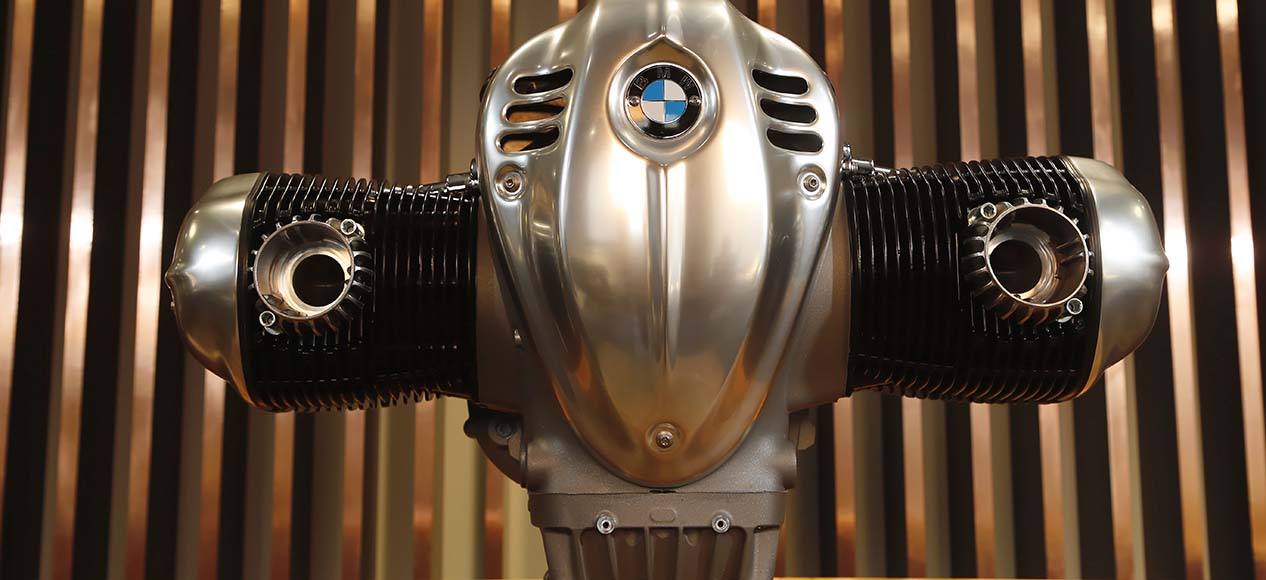BMW’s latest model release, the R18, features the German firm’s brand new 1,802cc ‘Big Boxer’ engine. Not just in terms of its iconic outward appearance, but also from a technical point of view, the new power plant ties in with the traditional flat twin engines that were synonymous with motorcycles produced by BMW Motorrad since 1923.
With its traditional overhead valve (OHV) valve train, along with a separate engine and transmission housing, the ‘Big Boxer’ has the same structural features that distinguished the very first BMW Motorrad engine. But where did the iconic boxer engine come from?
In the late 1890s, German engineer Karl Benz designed a new type of four-stroke engine. It was a flat, horizontally opposed twin cylinder engine that involved two pistons reaching top dead centre and bottom dead centre at the same time, with the piston action likened to two boxing fighters trading blows, and the term ‘boxer’ engine was born. The resulting engine design was reliable and developed good power.
Fast-forward to the early 1900s, and BMW engineer Max Friz designed a small boxer engine which became extremely popular with early motorcycle manufacturers in Germany, because of how compact it was. Nicknamed the ‘Bayern-engine’, it was originally placed in motorcycles with the two cylinders running the length of the frame, but this caused the rear cylinder to overheat as it couldn’t benefit from passing air to cool it down.
Turning it around
As BMW turned its attention to motorcycles following the First World War, Friz had the first BMW motorcycle on the drawing board by December 1922 with the flat-twin Boxer engine at the heart of the bike’s design. But to combat the rear cylinder cooling issue, Friz decided to simply turn the engine 90-degrees so that both cylinders stuck out the side of the frame to get sufficient airflow and cooling. Genius!
In 1923, Friz’s brainchild was released – the BMW R 32. It was the first motorcycle that BMW had built and it paved the way for all boxer-powered BMW motorcycles of the future. The 8bhp engine was fitted with a three-speed transmission and instead of using a chain to drive the power from the engine to the rear wheel, it was shaft driven for extra reliability. Following the R 32’s undeniable success, building and selling thousands of bikes between 1923-1926, BMW wanted more.
The next major step forward for the R 32 Boxer engine was a prototype that featured overhead valves. This new development was designed by engineer Rudolf Schleicher and was tested and officially approved when Schleicher rode the development machine at the 1924 ADAC Winter Rally – and won. The OHV design was incorporated into the sportier 1925 BMW R 37, which also included aluminium cylinder heads, representing a world first in standard motorcycle production. With nearly double the engine performance of the R 32 with 16Hbhp, the R 37 was an impressive machine to ride. R 37 riders racked up over 80 road race wins in 1925.
BMW continued to release popular boxer-powered motorcycles which increased in engine capacity, power and reliability. Customer sales were soaring too, due to the racing success and achieving new land speed records. Then in 1936, a completely new, revolutionary BMW model designed by Rudolf Schleicher was launched. The R 5’s Boxer engine produced an impressive 24bhp, but other interesting advancements caught the eye as well.
TT success
It had two camshafts, pedal-controlled transmission, a conical tubular frame made of seamless drawn oval tubes, and even had adjustable damping on telescopic front forks! The true potential of the BMW R 5 was proven when German motorcycle racer Georg Meier became the first “foreign” winner on a “foreign” motorcycle of the prestigious Isle of Man Senior TT race in 1939, achieving a 100mph+ lap.
The next major development to the boxer engine was post Second World War, in the 1970s. The new curvaceous-styled boxer engine was built to incorporate modern technologies and set a new standard and identity for future BMW motorcycles. The updated engines were introduction to the new /5 series models – the R 50/5 (498cc), R 60/5 (599cc) and R 75/R (745cc) – and eventually led to the big-bore 898cc R 90/6, R 90 S, and later the R 100 machines.
Then, during the early 90s, BMW saw an opportunity to rubberstamp the large-capacity touring segment, and launched the R 1100 RS on BMW Motorrad’s 70th anniversary in 1993. The R 1100 RS featured the latest R259 Boxer engine which was also used as a stress member as part of the RS’ frameless design. The engine was nicknamed ‘Oilhead’ as it had air-cooled cylinders but oil-cooled heads.
Nowadays, 97 years after the first BMW motorcycle was launched, over one third of its two-wheeled model range today are still powered by a variant of the legendary Boxer engine. Ducati and Harley-Davidson fans may disagree, but it’s arguably the most iconic motorcycle engine of all time!



